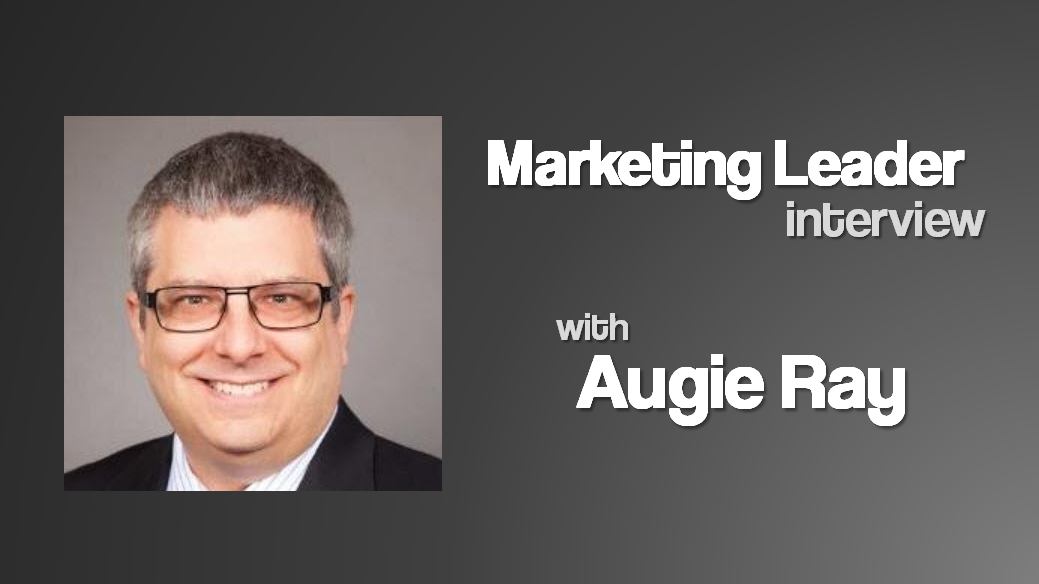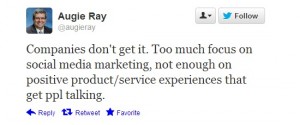Augie Ray is a good friend and a true thought leader in interactive marketing, social media and customer experience. He is a voice of customer leader at a Fortune 100 financial services firm. I met Augie when he was the lead Forrester Research analyst covering interactive marketing and social media.
You will find Augie’s perspective refreshing and insightful. Enjoy.
1. What company is an example of good marketing today? Who do you admire?
This may be a lousy way to start an interview, but there’s a part of me that wants to reject the premise of the question. Nowadays, thanks to the Super Bowl Ad Meter and social media “Likes,” everyone’s become an ad critic. But in the end, who cares what marketing any of us admires? Marketing isn’t about admiration or even popularity but about results–awareness, consideration, brand lift, acquisition and sales.
If I focus on outcome rather than output, I think Samsung’s strategy of tweaking Apple has been noteworthy. It started in 2012, when Samsung poked fun at people waiting in line for iPhones, and it has continued with the ads for Samsung’s tablets in the past year. One recent ad borrowed from Apple’s “Pencil” ad to demonstrate that not only is the Galaxy Tab Pro thinner than the iPad but it also permits multitasking.
The iPhone and iPad made splashes by being thinner, brighter and more functional than the competition, but Samsung’s product development and ad strategies have taken away that advantage. Today, Apple has stopped advertising features and instead relies on emotional appeals, and their ads have been somewhat hit (the “Misunderstood” holiday commercial) and miss (the pretentious “Your Verse” campaign).
No one would list the Samsung ads as their favorite, funniest or most artful campaigns, but those ads are getting the job done for Samsung. IDC reports that from 2012 to 2013, Samsung’s share of the smartphone market increased 43% while Apple’s rose just 13%. IDC also reports that Samsung’s 2013 Q4 tablet shipments were up 86% from the year prior compared to Apple’s increase of 14%.
2. Did you have a mentor or a person you learnt the most from? What was a key lesson?
My dad was probably my biggest mentor. I once attempted to start a digital agency with a friend, and my dad gave us some great advice: “If you land every pitch, you’re not charging enough.” Early in my marketing career, he helped me to understand it was okay to take a few at bats and not get on base.
My dad also had an impact on my attitudes about marketing and advertising–the ones so evident in my first answer. He would battle with creative directors who wanted to do more artful advertising than my father wanted for his clients, and my dad used to tell them, “If you want to create art, go hang something in a gallery. We’re here for commerce.” I probably make my dad sound like a killjoy, but he’s funny, vibrant and warm man. In his career, he cared more about bringing benefit to the client than about awards and accolades, and I see a lot of that in me.
I also felt I learned a lot at USAA. That company has terrific leadership, and I was inspired and impressed with everyone from CEO Joe Robles to CCO Wendi Strong to the VPs and Directors I worked with throughout the enterprise. I always believed that business success starts with corporate culture and mission, and my time at USAA only reinforced this belief. I feel like I apply things I learned at USAA frequently on my current job.
3. What story of a successful marketing strategy could you share?
I once had a brewing company as a client. They were doing the typical on-premise marketing where teams of attractive young people swooped into bars, interrupted people’s conversations, handed out some free product and schwag, and left.
At our agency, we felt this was doing little to create a positive, long-lasting brand impact, so we pitched a concept that involved custom, branded games projected onto walls at the bar. We started with five event teams tricked out with PCs, Wii controllers and projectors, and the test was so successful that within a year or so we had over 500 kits in the field. We eventually added social elements so that consumers could share scores and challenge friends, which only increased the reach and impact of the program.
I’m proud of this program for many reasons. We borrowed from the tenets of modern marketing to create an experience that attracted people rather than interrupted them. The program proved very popular–bar owners were asking the teams to come back time and again, which was unheard of. The program demonstrably impacted consumers’ preferences, and brand lift studies found that markets with our kits were performing better than those without. And, of course, this program was good for our agency–for years, we continued to develop new seasonal games, support the technology and assist with the training of the event teams.
4. What is your marketing superpower, the most important skill that makes you a great marketer?
I think my marketing superpower is that I never really considered myself a marketer but more of a customer experience professional. I’ve done little traditional advertising or marketing in my career–for almost two decades, my focus has been on how to use digital and social media to create experiences, encourage WOM and improve the customer experience. (This is why my blog was named “Experience: The Blog” and not “Marketing: The Blog.”) I have never felt it was enough merely to get impressions and clicks; my passion has always been around how to connect bands and consumers in more meaningful ways.
5. What interesting book have you read recently?
I’ve been taking a break from business books. I was feeling a little inundated with the constant stream of social and marketing news, opinion and data that arrive via Twitter, Flipboard, Zite, Facebook, email and Google+, so I decided to turn some attention to fiction for a while. In the past several months I quite enjoyed “The Golem and the Jinni” and “To Say Nothing of the Dog,” and I polished off “The Goldfinch.” The latter tried my patience and made me wonder if the pace and brevity of social media was ruining me for slower, more deliberate works of fiction.
6. What new, modern tactic, tool, or aspect of marketing should marketers pay more attention to?
I think there can be too much emphasis on finding the new. Most companies have still not gotten social and mobile figured out, and rather than chase the next hot new thing (Quora! Gamification! Snapchat! Vine!), I think brands should really focus on what they are getting out of some the channels in which they’re already investing.
If I was going to advise marketers on where to focus in 2014, it would be on Content Marketing, but probably not in the way you might expect. A lot of brands have been sold on the concept of content marketing and have ramped up their content marketing teams, but the trends in content marketing are not encouraging. Facebook engagement is dropping and will continue to do so. On Twitter, it is hard to stand out. Corporate blogs and YouTube channels more often than not do not generate significant repeat traffic. We live in a world where consumers are deluged with content, and brands have been too quick to assume theirs can stand head and shoulders with Rihanna, PewDiePie, Gaga, Fallon, and George Takei (not to mention the content shared by our friends.) I think 2014 will be a time to reassess the costs and investment in branded content and to consider (once again) how to get consumers talking FOR brands rather than get consumers listening TO brands.
7. What good aspect of basic marketing have marketers neglected in recent years?
Metrics. It’s time for some back-to-basics marketing metrics.
Every time a new channel comes along, some people want to rewrite the way marketing is measured. For a while in the Web 1.0 era, people focused on hits and page views, but in the end, it came back to traditional measures of acquisition, sales and brand lift. Then social came along, and it was the same way–suddenly “friends,” “likes” and “followers” were the way to measure success, but the time has come for that sort of thinking to die.
Last year, Kmart had one of the most successful viral campaigns of any brand with “Ship My Pants,” but that hasn’t stopped the retailer from continuing to lose market share. The chief digital marketing officer for Sears, Kmart’s parent company, said he judges success by “the amount of engagements in social media surrounding the brand.” It is long past time for digital and social media leaders to stop this kind of idiotic babble. Marketing that entertains or engages without driving measurable brand or business benefits is failed marketing. I hope we’ll see a return to focusing not on new social metrics but on old-fashioned brand and business metrics.
8. What skills will marketers will need in the future? How do you stay sharp?
The way I stay sharp is blogging. It forces me to take an idea or concept that is bouncing around in my head and flesh it out. I often find that concepts about which I am quite confident do not seem quite so ironclad once I begin the process of research and writing. Sometimes, I end up killing my own ideas; other times, I end up reinforcing them with more data and analysis. Either way, this process enhances the ideas, insights and opinions that I use on the job. Blogging also forces me to stay current on happenings in the social and marketing world and requires me to evaluate and have an opinion on the news.
I sometimes think about ending my blog–it takes A LOT of time–but I fear I would lose too much. To me, blogging isn’t just about the readers, comments and tweets (although I always appreciate those) but about staying sharp, current and in the know.
9. What was the turning point in your career?
I’ve had a couple turning points. The first was when the Web went public. I was on Prodigy at the time, and when the ISP opened up the Web, I immediately started creating web pages as a hobby. Before too long, I was coming up with ideas for how this web technology could be used to benefit the life insurance company at which I worked, such as offering forms for consumers to download or providing a searchable support database for customer care professionals. Those ideas now sound pretty basic, but in 1998, they seemed pretty wild to a lot of people. In the course of a couple of years, I went from managing a customer service division to running a digital agency team.
Another turning point came when I launched my blog, or more the point, when I published a blog post critical of a Forrester report. I felt Forrester had not gone far enough to warn marketers about the risks of “sponsored conversations,” and I said so on my blog. As a result of my post, a conversation developed with Josh Bernoff and Sean Corcoran, and not only were they impressive and smart but also very open to the critique. A few months later, Forrester was seeking a west coast analyst, and I reached out to Sean and Josh. I still had to earn the job offer (including writing and presenting a report), but without that blog post and the dialog that followed, I doubt I would have made the first cut.
10. How do you increase marketing’s relevance and influence in the organization?
I believe the CMO has to be more than just the Chief Advertising Officer. Marketing has to focus on how the brand is crafted with experiences at every touchpoint and needs to consider the entire funnel and not simply how to fill the top of it.
Many will say that marketers already understand this, but the rise in recent years of Chief Experience Officers and Chief Customer Officers demonstrates the opportunity lost by the CMO and Marketing Department. Marketing should already have been the center of excellence for customer experience and customer focus, and the fact they were not is an indictment of how poorly some Marketing Departments have been led. I think the time has come for Marketing to be as focused inside the enterprise as they are outside.
11. What blogs would you recommend?
I’d recommend Convince and Convert, Social Media Examiner and PR Conversations.
12. How would you summarize your digital marketing strategy?
Create experiences that matter.
Thanks Augie!
You should follow Augie on his blog at www.ExperienceTheBlog.com on Twitter at @AugieRay and on Google + at google.com/


